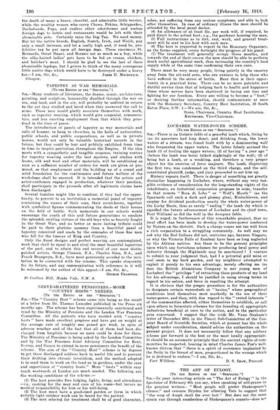TAPESTRY AS WAR MEMORIALS.
[To THE EDITOR OF THE " SPECTATOR."] Sia,—Many students of literature, the drama, music, architecture, painting, and sculpture, honourably disabled through the war on sea, and land, and in the air, will probably be unfitted to return to the art they studied and loved when they answered the call to . arms. These men would gladly associate themselves with work, such as tapestry weaving, which would give congenial, remunera- tive, and less exacting employment than that which they prac- tised in the time of peace.
The introduction of panels of tapestry as war memorials and rolls'of honour, to hang in churches, in the halls of universities, public schools, and public corporations, as well as in private houses, would not only be valuable historical records in the future, but they could be lent and publicly exhibited from time to time to inspire patriotism throughout the Empire. If the idea meets with a sympathetic and tangible response, training centres for tapestry weaving under the best masters, and studios with looms, silk and -wool and other materials, will be established as soon as a sufficient number of orders for work are given or pro- mised, so that employment and the building up of a sound and solid foundation for the continuance and future welfare of the workshops shall be ensured. It is intended that the artists and artist-craftsmen engaged in production, whatever their position, shall participate in the proceeds after all legitimate claims have been discharged.
Several families might like to combine, if they had the oppor- tunity, to present to an institution a memorial panel of tapestry containing the names of their sons, their escutcheons, together with symbolical figures commemorating the deeds of their heroes on the field of battle. Such memorials in our schools would encourage the youth of this and future generations to emulate the splendid, sterling virtues of the old boys who so bravely fought in the Great War, and no better or more lasting tribute could be paid to their glorious memory than a beautiful panel of tapestry conceived and made by the comrades of those fine men who fell for the honour of King and Country.
Only the finest designs and perfect weaving are contemplated, work that shall be equal to and rival the most beautiful tapestries of the past, and to attain this end several of our most distin- guished artists, George Clausen, R.A., Charles Sims, R.A., and Frank Brangwyn, R.A., have most generously acceded to the invi- tation to be connected with the scheme. This speaks eloquently for its future, and any, communication with reference to it will be welcomed by the author of this appeal.—I am, Sir, &c.,


























 Previous page
Previous page